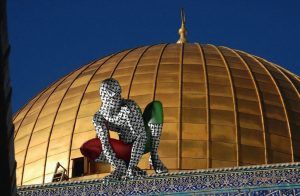Nicholas Pelham in More Intelligent Life:
 When Muhammad bin Salman, Saudi Arabia’s Crown Prince, visited New York earlier this year, the face of Ahmed Mater, the kingdom’s most celebrated artist, was beamed onto an enormous billboard in Times Square. In recent years, he has been feted at exhibitions in London, New York and Venice. He dominates the Saudi art scene so thoroughly that his peers struggle for attention. “He’s the only artist anyone writes about,” says one Saudi curator. In 2017 Mater was appointed as artistic director of the Prince’s cultural and educational foundation, entrusted to promote art across the kingdom and liberalise the school system. He plays a crucial role in the enormously ambitious plan for economic and social transformation, which aims to wean the country off reliance on oil revenues, strip down the power of clerics and dispel a reputation for medieval obscurantism and misogyny.
When Muhammad bin Salman, Saudi Arabia’s Crown Prince, visited New York earlier this year, the face of Ahmed Mater, the kingdom’s most celebrated artist, was beamed onto an enormous billboard in Times Square. In recent years, he has been feted at exhibitions in London, New York and Venice. He dominates the Saudi art scene so thoroughly that his peers struggle for attention. “He’s the only artist anyone writes about,” says one Saudi curator. In 2017 Mater was appointed as artistic director of the Prince’s cultural and educational foundation, entrusted to promote art across the kingdom and liberalise the school system. He plays a crucial role in the enormously ambitious plan for economic and social transformation, which aims to wean the country off reliance on oil revenues, strip down the power of clerics and dispel a reputation for medieval obscurantism and misogyny.
Prince Muhammad has travelled the world to convince business leaders, tech titans and entertainment impresarios that Saudi Arabia is a place where both popular and high culture can flourish. For the first time in over 30 years, cinemas show films. For the first time ever, pop stars perform in concert halls. Mater has accompanied the prince on his pilgrimage as the epitome of the country’s artistic reawakening. When the Saudi Crown Prince met Xi Jinping, he brought Mater along and gave the Chinese president one of his paintings as a gift. The story behind Mater’s rise is more complex and ambiguous than his current pre-eminence suggests. It illuminates the unprecedented liberalisation that many of the country’s cultural elite are experiencing at the moment, as well as the compromises with power that they must still make. Mater did not reach the pinnacle without help. But some of his companions have fallen by the wayside. “Of course”, one Saudi artist tells me, “it wouldn’t have happened without Ashraf.”
More here.
